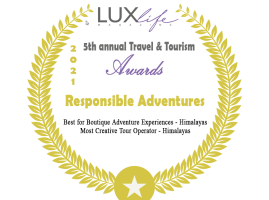Am I too old to go trekking in the Himalayas?
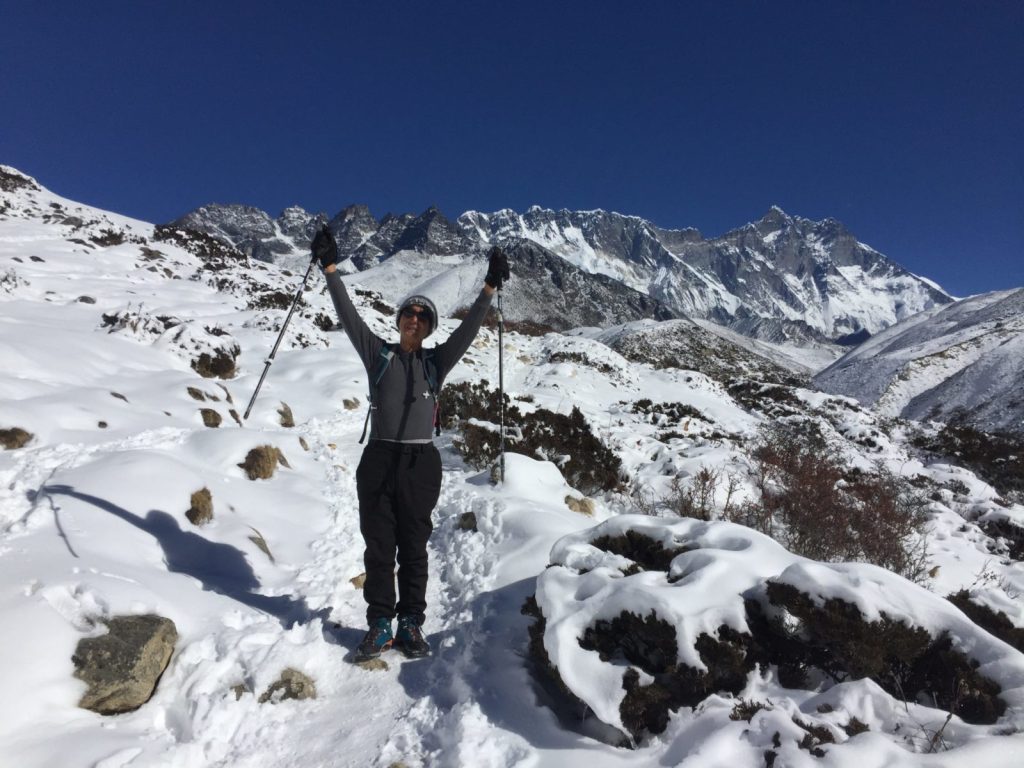
It is a great healthy lifestyle if you have been hiking/trekking or any form of exercise. However, if you haven’t already done it, you are not the only one!
How to choose the right partner or partners for a trekking vacation
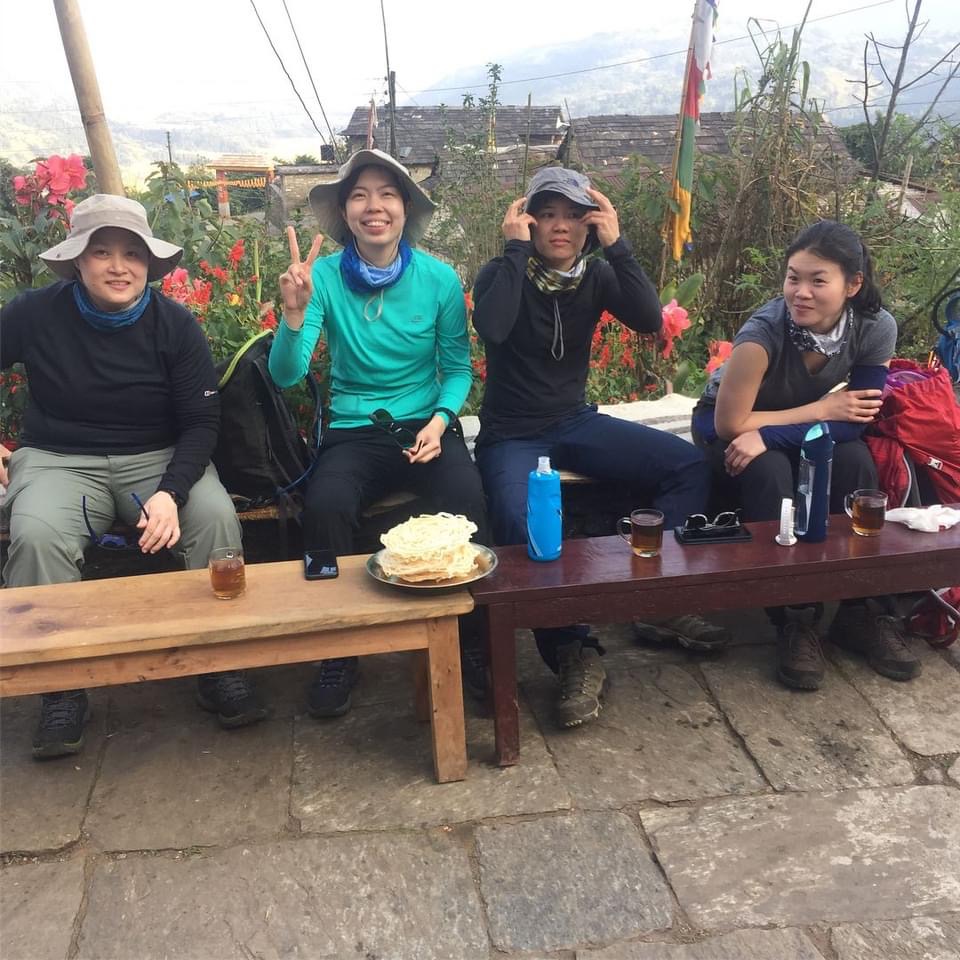
How to choose the right partner or partners for a trekking vacation. Trekking is an adventurous activity, and it can be memorable if the right trekking partner or partners accompany you. The right trekking partner can be an essential part of your trekking experience. It would be best if you had a reliable, competent, and trustworthy trekking partner in a risky situation in the mountain environment. Here are some of the ways to find the right trekking partner and have an excellent trekking partnership. Ideally, if you have someone with whom you have been on extended hiking trips before and have gotten along well in the past, fantastic! However, you could still meet a new person with matching thoughts and ideas and end up having a partner in adventure for life. 1. Knowing Yourself The first step is to understand yourself: You need to know what you intend to achieve, your expectations, and your trekking partner; complete compatibility is essential. Check if your personalities, expectations, preferred routes, and budget match. Get a feel for your trekking partner’s personality and ask yourself if you are comfortable with it. While doing so, put yourself in their shoes and see if you are an excellent trekking partner for them as well. This should help you understand what you want in a partnership while trekking in a serene mountain environment. 2. What you seek in your trekking partner It is critical to know your partner/s before going on the trek with them. One suitable way is to look at their social media pages to learn more about their activities, personalities, likes, etcetera before embarking on a trekking vacation. i) Age and fitness Well, age should not be a critical criterion in deciding the compatibility of your trekking partnership. However, it would be best to consider their physical fitness, their hiking experience, and their expectations of the trekking pace. The partner’s speed and physical fitness can be a factor that determines the trekking route and the number of trekking days you choose. Having said this, trekking at your own comfortable pace alone can be a self-discovering experience. You can contemplate in silence while admiring the beauty of nature while hiking on your own. You could even do a meditative walk on your hiking vacation. ii) Gender Having the opposite sex as a trekking partner should not be too inconvenient, as long as you have mutual respect, personal space, and privacy to change clothes, etcetera in the room or tent. If you snore, inform your partner to invest in a pair of earplugs. iii) Hiking Experience If your trekking partner is experienced, it can be advantageous for you to guide trek preparation. Talk about each other’s experiences, strengths, and weaknesses. d) Nature of your partner What do you like doing, e.g., do you want to have a quiet read or listen to music in your free time while taking in the surrounding mountains’ beautiful scenery? What if your partner is a party animal and loves hanging out late every night during the trek? Everyone is different, and that should not be too much of a problem as long as they do not disturb you when they return to the room. Invest in earplugs, as some people tend to snore after a few drinks, and the walls of the lodges can be paper-thin. e) Trekking Partner’s expectation Ask and understand what they expect from you and check to see if it is compatible with your plans and expectations. If the expectations match, this could be the beginning of a great partnership in the adventure. 3. Communication Excellent communication is an essential factor in all good alliances. Communicate your plans and expectations with your trekking partner before and during the trek. Get an understanding of what they expect from you – go on and see if it matches yours. Inform your partner in advance if you have an existing medical condition or ask if they have one and if they have life-threatening allergies and if they are on medication. It is good to meet your partner and go on hikes in your home country a few times before going for an extended trekking vacation overseas. Making some parties’ adjustments is expected, so be flexible and prepared for compromises. 4. Set up an understanding It is always good to have clear, predetermined matters with your partner about various critical issues that can take place during the trek. Discuss things like, How will you split your trek costs and have a plan of action in an emergency? Inform your partner where your insurance papers are, whom to call in case of an emergency, etcetera. Share the responsibilities and appoint roles precisely, so you do not need to decide everything by yourself. In conclusion Once you have used the tips above, you have found your ideal trekking partner, and planning your extended trekking holiday as an essential part of choosing a partner is out of the way. All the best for a great trek and many more future adventures to follow with your newfound trekking partner or partners.
Top fun things to do with children in Nepal
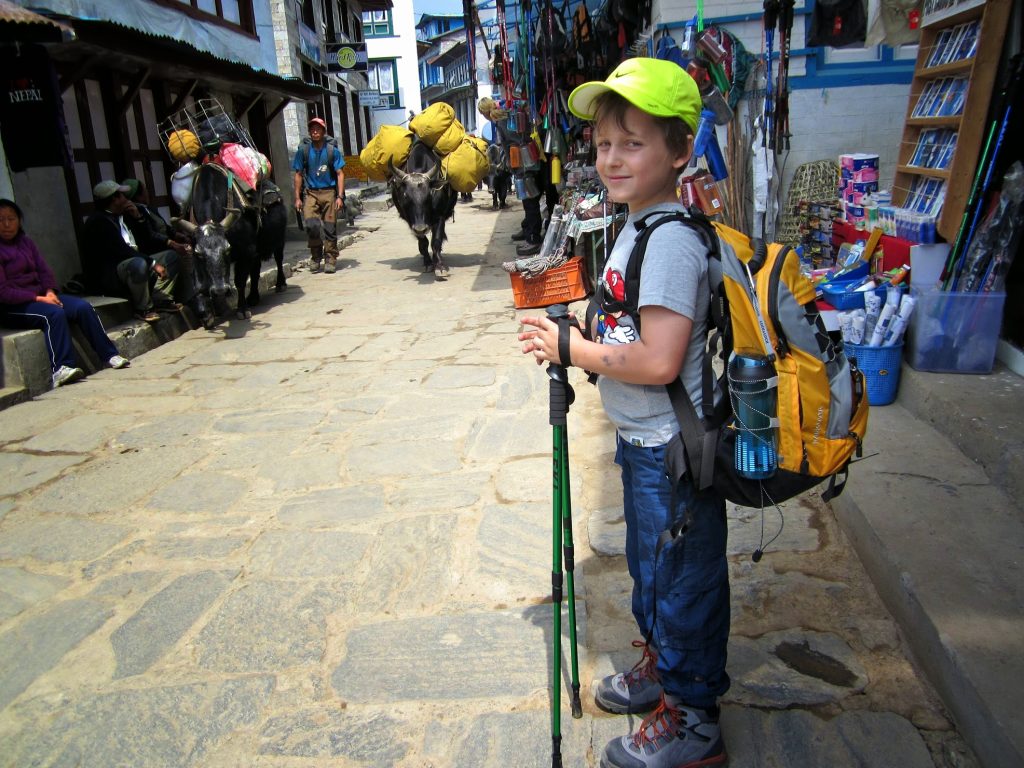
Things you can do that are not mentioned in the travel guides: Kathmandu 1. Kathmandu Zoo The Kathmandu zoo isn’t well known as some zoos in other countries, but you will be pleasantly surprised by how the animals appear pretty content and well looked after. If you go there on Saturdays (the weekly day off in Nepal), it can be busy with families with children and an excellent opportunity for your kids to interact with local children. If you go there during the weekdays, you might see some school children on their educational excursion. Most of the animals at the zoo are native to Nepal. Some include the langur, rhesus monkeys, four varieties of deer, leopards, the Royal Bengal tiger, and numerous birds. You can also hire a paddleboat and go rowing on the lake. You can opt for an elephant ride if you are not planning to visit Chitwan. Elephant rides are usually available after 1 pm as they are taken out in the morning to collect their food. It can be a bumpy but fun ride. 2. Patan Durbar Square You can take a short taxi to Patan Durbar square if your children are not exhausted after visiting the zoo. You can walk around the World Heritage site; have lunch or high tea there. You can make the stay as short or as long as your kids’ condition allows. 3. Rickshaw Ride in Thamel You can take a rickshaw ride through the narrow streets of old Ason to the Kathmandu Durbar Square from Thamel – the tourist district, and return for lunch, high tea, or dinner. It would be best if you fixed the price for the ride before you embark on it. 4. Buy colourful Tikas in a stand outside Thamel in Kathmandu. Pokhara and surrounding areas Pokhara is the adventure capital of Nepal. It is an ideal place to chill out or participate in adventurous activities. 5. Trekking in the Annapurna region. You can opt for a trek from a single day to a multi-day hiking adventure with your family. It is best to “invest” a bit more in a premium company for safety and the best experience for your family’s trekking holiday. Having a knowledgeable and caring trek leader/guide, porters can add value to your family vacation. The Annapurna region is an excellent choice as you can opt for a mid-altitude trek and not worry about Acute Mountain Sickness for your family. If your kids are too young, you can ask the trekking agency to provide extra porters to carry your kid/s when they get tired or bored. It is a great way to introduce your children to nature and bond as a family unit. Bring some games and playing cards to spend time both as a family and getting closer to your support team. There will be children from the village with whom your kids can become friends. Your family will cross some suspension bridges, which can be a lot of fun. Your children will probably love watching the numerous domesticated animals when you hike through villages, not forgetting the beautiful views of the Annapurna range on clear days. Having a first aid kit is suitable for your peace of mind. Simple things like having a hand sanitiser handy and drinking boiled and filtered water at all times can help prevent stomach ailments. In addition, it is advised to bring multi-vitamin snacks for an activity like trekking for your kids. 6. Eat Lemon Meringue at Moondance Restaurant, Pokhara Visitors to Nepal might have heard of Dal Bhat, the national staple diet which consists of rice, lentil soup with vegetables, and meat curry (mostly chicken and mutton) with spicy sauce. In addition, you will be pleased to find various international cuisine available in popular tourist hubs like Kathmandu, Pokhara, and Chitwan. The Moondance Restaurant in Pokhara is highly recommended. They have a selection of comfort food, gastronomical delights, and board and card games. Many more good restaurants in Pokhara serve various local and international cuisines. 7. Pony ride around the Lakeside in Pokhara The ponies might look tired and small compared to the bigger better-groomed horses in the West. It would be helpful if you could bring the ponies some treats like carrots or apples. However, the ponies are gentle, and their drivers are usually friendly. It is best to start from Halan Chowk and head towards the less busy Pame side. It is another suitable way to spend time around Phewa Lake. 8. Paragliding in Pokhara There are numerous paragliding companies in Pokhara. For the same price, why not fly with the company owned by two Nepalese guys who climbed Mount Everest, paraglide down to the Sun Koshi River, and kayaked to Bengal’s bay in 2011? They won the National Geography Adventurers of the year 2012. Their company is called Fly Himalaya. 9. A yoga course in Pokhara with the kids- warmly recommended. There are several yoga studios around Lakeside in Pokhara. You can easily walk into several and ask if they have a family program or for the kids. 10. Day hike near Pokhara If you opt not to go on a multi-day trek, you can go on a short easy hike to the village of Astham. There are several fantastic guesthouses there. If you are not on a tight budget, you can stay at an organic lodge on a Japanese/Nepalese joint venture. 11. Women’s cooperative shop Tara’s shop is part of an organisation that supports women workers, and you can visit this fair trade shop to help empower them. It is situated in front of the “Be Happy” restaurant. You can visit Tara’s shop in front of Be Happy restaurant in Lakeside. It’s an organisation that supports working women. See how they spin the strings, dye them, and make them into fabric they use to make all sorts of bags, gloves, stunning hats, etc. 12. Taste organic Honey Taste organic Honey from wildflowers that grow only at high altitudes or Butternut
A wedding in remote Nepal
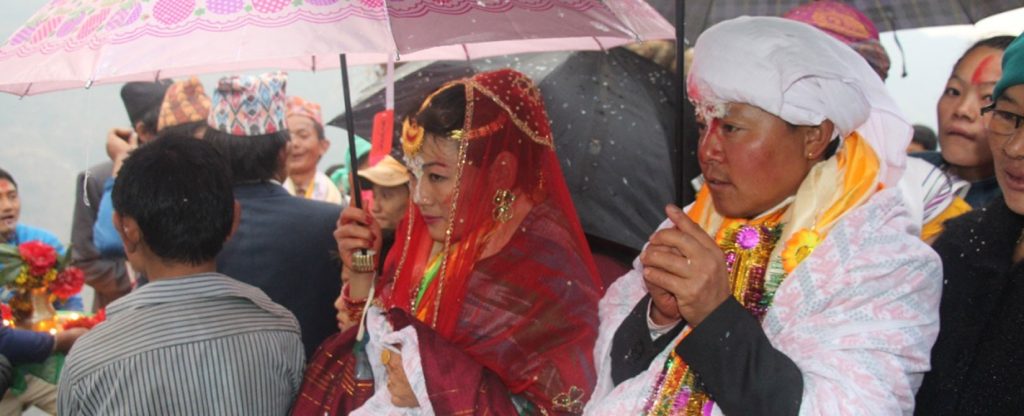
Attending a wedding in remote Nepal We recently concluded a trek to remote Sotang Village Municipality’s village to attend and financially support the wedding of our dear and longest-serving staff Chandra and his bride Manku Rai. We had planned it so our previous and new customers could experience cultural immersion by attending a wedding in Real Nepal ? away from the touristy places 99% of the visitors to Nepal go to. The whole wedding experience was planned for a week. The joining date of the trip coincided with Valentine’s Day. We had four overseas participants ? an Australian couple who have done two treks with Chandra; two Singaporeans ? one who has done several treks with the groom, and the other who has made three trips with us. The Journey to the Wedding. We had a long drive towards Salleri on the second day. We drove on a winding road along the Sun Koshi River until we reached Harkapur of Okhadhunga district, where we started ascending. Despite the relatively short distance and good road conditions, it took us longer than expected. Being stuck for forty-five minutes in a traffic jam in Kathmandu didn’t help. We had a team discussion and decided to stay at Patale for the night. Upon reaching Patale, we checked out the rooms, which were basic but neat and clean; we ordered some refreshing black tea and Dal bhat (Nepalese staple diet) for dinner. It was a cold but clear night at 2875 meters, with stars shining brightly as there were no light disturbances. We had an early night so we could have an early start. The following day was clear, and we took the wedding participants for a surprise view of Mount Everest and other giant Himalayan Peaks before breakfast. After that, we headed for Salleri, the district administrative centre for Solu Khumbu district; the jeep got refuelled. We left the blacktopped road a short distance after refuelling, and the bone-wrenching journey to Sotang began. However, the scenery made the rough drive somewhat bearable. It took us about three hours to reach the Dudh Koshi River before the last leg to Sotang Bazaar. The River was only made possible to cross from the previous winter with a temporary “bridge” built over it. The final 5 km was the most challenging part of the journey, where some passengers had to descend at a few places so the jeep could manoeuvre over steep dirt road sections. The 5km drive took us ninety minutes. Once we reached Sotang Bazaar, we went to our staff Sundar’s “hotel” to have our preordered lunch while our seven porters were busy offloading our camping gear from the jeep and divided it into equal loads. We had a two and half hour hike to Majh Kharka ? the groom’s village. The walk was relatively comfortable, with a small ascend for about forty-five minutes to the top of the hill. The trail then became short descents, undulating before we started a short climb to the groom’s home. Chandra eagerly awaited our arrival; his family members warmly welcomed us. Our porters arrived shortly after us; they and our support team got busy setting up our tents on the local “Youth Club grounds.” We were invited to dinner with the groom’s family, as they were ‘free’ before the wedding rush began the following day. Once our campsite was ready, we set our respective tents up and got ready for the evening. The Rai ethnic group and their traditions Chandra belongs to the Kirat ethnic group of the Rai and Limbu communities, with numerous clans and sub-clans. The Kirats are some of the first recorded people to have ruled Kathmandu in Nepal’s history. They practice a mixture of ancient animistic religions worshipping the forests, rocks, rivers, and everything to do with nature and some Hindu rituals. The most important part of their diet is pork ? every household rears a pig for special occasions. They also love their alcoholic drinks, namely Chang ? fermented grains, but millet is their grain of choice, which they drink instead of water and Rakshi ? distilled homemade liquor from fermented millet. Alcohol is consumed in all their essential rituals. Pre-wedding family dinner We went into the ‘kitchen’ of the family, where a fireplace is set in the middle with four poles on each corner ? an essential part of the Rai ethnic group’s traditions. Unique places are set for the elders according to their importance in the family. We were invited to sit with the family members and were served Rakshi ? their homemade liquor. Culture and traditions were explained to the guests. It appeared that their weddings were very well organized with various chores/duties assigned to a different set of people ? mostly all relatives. It starts with a guy who estimates the whole wedding budget; I jokingly called him the CFO, a team each for making Chang, Rakshi, purchasing, cooking, the sisters and female cousins were in charge or serving alcohol to all present ? they made sure everyone had plenty. So we had plenty to drink and a good dinner of pork curry and rice. We went to bed feeling relaxed after the consumption of rakshi despite the bone-wrenching ride that morning. Final preparation day We were woken up with an ayurvedic drink delivered to our tents. This drink is excellent as it has anti-inflammatory properties, provides exceptional energy, and gets rid of cancerous cells. One of our host’s cousins had kindly invited us for breakfast. The morning activities consisted of going for breakfast, having tea with another of our host’s cousins, and visiting the local school to watch a pig’s ritual killing before lunch. Our overseas guests were treated to an excellent and healthy meal prepared by our trekking chefs while we went for lunch at a relative’s home. The villagers are so hospitable and accommodating. We were invited to many of their homes for tea and meals; sadly, we couldn’t visit every house that welcomed us.
Holi or Fagu Purnima the festivals of color in Nepal
When does Holi take place? 29th and 30th March 2021 10th and 11th March 2020 20th and 21st March 2019 Holi or Fagu Purnima’s date changes according to the Hindu calendar. The Hindu calendar is based on solar and lunisolar calendars. It is very different from the Gregorian calendar, so most important festivals occur on other dates or even months on the Gregorian calendar. In Nepal, we have a unique practice where the hillmen celebrate a day ahead of the Terai residents. Like many of the festivals of this region, there are many myths and stories behind each festival. Holi is welcoming spring and summer. It is also observed to get a blessing of God for coming harvests and fertility of the land. This festival is celebrated in most South Asian counties. Holi takes place on the night of Falgun Krishna Chaturdasi. However, the celebration starts on the next day of the Fullmoon (Purnima). Holi is the festival of colour, camaraderie, and love. How Holi is celebrated Holi in Nepal starts a week before the primary day of the festival. The tradition is to erect a long bamboo pole covered with different coloured cloths (called Chir locally) in Basantapur, Durbar Square. On the eve of Holi, the bamboo pole (lingo) is brought down, and the bamboo pole (Chir) is burnt. This occasion is known as Holika Dahan or Chir Haran, after which the festival of Holi begins. This festival is celebrated with colours, music, sweets and most of all with water. The participants put colours on one another, a token of love. People go from house to house with relatives and friends in groups during the celebration. Putting coloured powder or liquid form while eating traditional Indian sweets throughout the day is how they celebrate Holi. Some people also play music and dance during this festival. The people of the hills in Nepal celebrate this festival a day ahead of the Terai region and India. Therefore the festival of Holi is celebrated for two consecutive days by the different areas of the nation. Some participants use water guns to squirt water on others during the celebrations. Traditionally it used to be made of bamboo, but these days modern plastic water guns are used. In addition, the popularity of balloons and plastic bags filled with water is a less expensive way to have fun for the youth. Children start throwing water-filled plastic bags and balloons as early as a week before Holi begins. People gather firewood to light fires while playing music and dancing. Some indulge in bhang (an edible cannabis preparation) with mixed lassis to enhance their celebration. The alleys of villages and towns are alight with firewood. This is considered an essential part of the Holi festival. It symbolizes the end of Holi (Holika Dahan). Government offices are closed on Falgun Purnima in the hilly regions of Nepal as Holi is an official holiday here, while the Terai region celebrates Holi the next day. Tales behind Holi There are numerous stories behind the Holi festival. Lord Krishna and Radha It is said that Lord Krishna was continuously moaning to his mother, Yasodha and that all his girlfriends teased him by calling him the dark one (Kala). He is believed to have asked Yasodha why he was dark when all his girlfriends (Gopinis including his beloved Radha) were fair. Yasodha, in turn, gave Krishna various colours and asked him to throw them on all the Gopinis’ faces so they too would look dark like him. Krishna brought the colours and applied them to all the Gopinis. The Gopinis loved the colours as they were all head over heels in love with Krishna and enjoyed the occasion. This is one of the tales of how Holi began. Death of Holika It is also believed that Holi is the day Holika died. It is to celebrate her death. Praladh was the son of Hiranyakasyapu, a demon. Hiranyakasyapu thought of himself as the most powerful being in the Universe and wanted everyone only to worship him. Praladh, on the other hand, was a devotee of Lord Vishnu. Hiranyakashyapu tried to convince his son numerous times to worship him but failed miserably. So Praladh continued to worship Lord Vishnu. Hiranyakasyapu plotted the murder of his 5-year-old son. He ordered Holika, his sister, to kill Praladh. Holika was gifted with a fireproof dress. It is believed that she carried Praladh into a flame. However, due to his faithful devotion to Lord Vishnu, Lord Krishna came to his rescue and burnt Holika instead. Holika Dahan, which means the end of Holika, is now known as Holi. People celebrate the death of Holika with colours to this day. The people make a replica of Holika out of hay and burn it at the festival of Holi. Krishna and Draupati It is also said that Holi is celebrated to honour Krishna’s protection of Draupati’s modesty by producing several lengths of cloth when the Kauravas stripped (Cheer Haran) her. At the same time, her husband, the Pandavas, hung their heads in shame. So it is another tale linked to the celebration with Holi. Dhundi and boys Another tale has it that once upon a time, in the Kingdom of Prithu, a horrible ogress called Dhundhi began to trouble the children. She had received a boon from Lord Shiva, which protected her from getting harmed by Gods, men, weapons, heat, cold, snow, or rain, making her more or less indestructible. However, Shiva had also given her a curse whereby boys could be dangerous to her. Through the advice of his priest, King Raghu arranged for some boys to go out seeking the ogress with wood in their hands. They were further empowered with mantras to go around Dhundi thrice while chanting them, making loud noises to annoy the ogress. On the first day of spring, the group of boys collected firewood, lit it alight, and started dancing, and the consumption of bhang intoxicated them. Then, in the influence
Corporate Social Responsibility of an adventure tour operator in Nepal
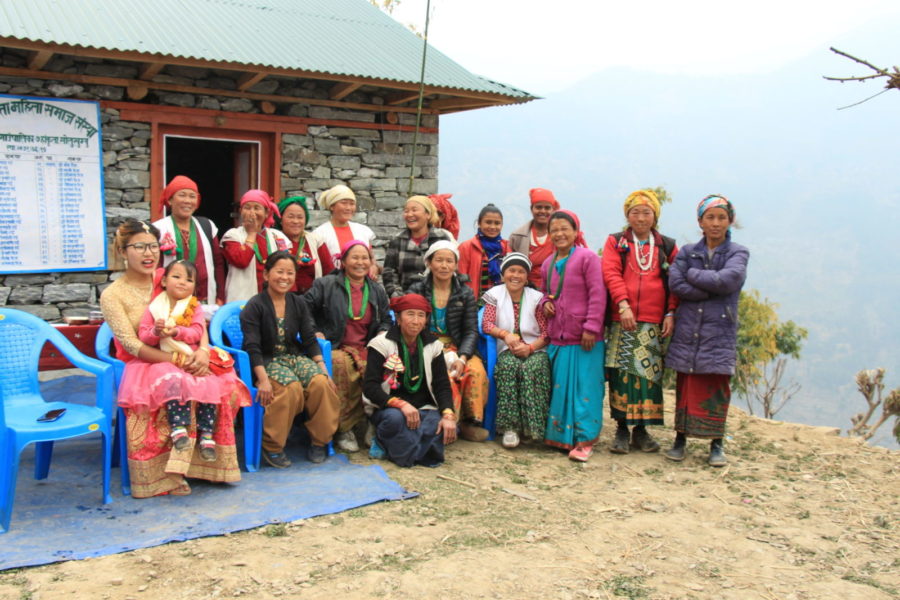
Our founder, Rajesh Kumar Tamang, aka Raj, believes Charity begins at home. He says our biggest asset is our staff: happy porters, talented support crew, trekking chefs, and expert trek leaders. He says, “We value our staff highly.. after all, happy staff makes happy customers! We have handpicked and trained our field staff, who are experts in their duties to make your trek enjoyable.” Responsible Adventures is committed to a fair-trade approach and practice, namely Genuine Responsible Tourism. Providing our staff with a dignified working environment is of utmost importance. We pay our team a generous wage to help them improve their lives for themselves and their families. Another aspect of our CSR is making sure most of your money will benefit the region and the people you are trekking with. Despite being a relatively small company, we have set high standards and integrity. Our handpicked and highly trained employees can proudly say that we provide excellent value for money and unparalleled trekking services in the Himalayas. Looking beyond our company walls, Raj has been volunteering as an instructor of Wilderness and Advanced Wilderness First Aid training to teach Trek leaders and trekking guides of international tour operators since 2011. After the massive earthquake in April and May 2015, Raj helped Non-profit organisations by providing his employees as volunteers to help bring relief materials to affected villages in certain parts of Nepal. He has volunteered to educate children on the policies of leaving no trace on hiking trips. Instead, he teaches the children to leave nothing but footsteps and take nothing but the appreciation of nature. In December 2015, he went to the remote villages of Solu Khumbu, where most of his employees come from, with some donations to help partially with the maintenance and construction of schools. Raj has volunteered as a “Medic” for outdoor events, such as the Nepal NCA Mountain Bike Championship on March 19th, 2016. In addition, Bhote Koshi expresses a kayak competition from October 25th until October 29th and the Kathmandu Mountain Bike Festival from the 18th to the 20th of October 2016.
8 Reasons To Explore The Great Outdoors
There are many reasons to explore the great outdoors, and for some, it’s even difficult not to, but with exploration comes excitement and new adventures. But maybe it doesn’t sound all that fun to you, perhaps you’re scared of nature, or maybe you don’t enjoy it that others do, which is fine, but there is a bonus if you will find yourself out there. Being in nature is natural to all humans; it’s so natural that humans made the word natural off of nature. Staying indoors is not so natural, at least staying indoors for prolonged periods without interacting with the sun. And our bodies don’t really like not having the sun or fresh air, among other things. But it does like nature, which is known because there are known benefits to going outside and exploring. Relieve Stress To start with science, cortisol is a hormone in the brain correlated to stress. So the more stressed you are, the more cortisol you have; logically, less cortisol equals less stress. And you can get less cortisol by going into nature, exploring, being relaxed, and enjoying nature because the forest is not stressful compared to your job or everyday life. Being less stressed can open many doors for you; being less stressed means that you are overall more patient and therefore have more time to think about decisions and think things through; it’ll make you more appreciative as you pause for a second rather than walking past all there is to see. Increase Mental Energy As mentioned, less stress is better for your body because it reduces your mental state. But going into nature relieves stress while rejuvenating your mental state, giving you more mental energy. So heal yourself by taking a waltz into your heart, allowing you to think more clearly and carry on easier. If you’re like most people, you can sometimes be overwhelmed or bored with the same old sights, the same old town or city, which is tiring, and you only become gradually more tired. This is why taking a trip to spend time in nature is a good thing because it will allow you to relax fully and make you happier in the long term. Boost Your Immune System The two points have been about mental health, which can be different for everyone, either stronger or weaker, more susceptible to mental fatigue, and the like. But this one works for everyone, albeit on different levels but still. In addition, being in nature boosts your immune system, allowing you to fight off any pathogen more effectively, and you’ll be less sick with the common cold, which is always a benefit. This is due to phytoncides, or at the very least, scientists believe. There’s strong evidence to suggest that being in nature boosts your immune system, but no one is exactly certain as to why. But phytoncides could be it, which are the airborne chemicals that plants emit, which increase the count of white blood cells, cells which fight off disease.
Everest base camp trek with the highest golf tee offs by a foreigner
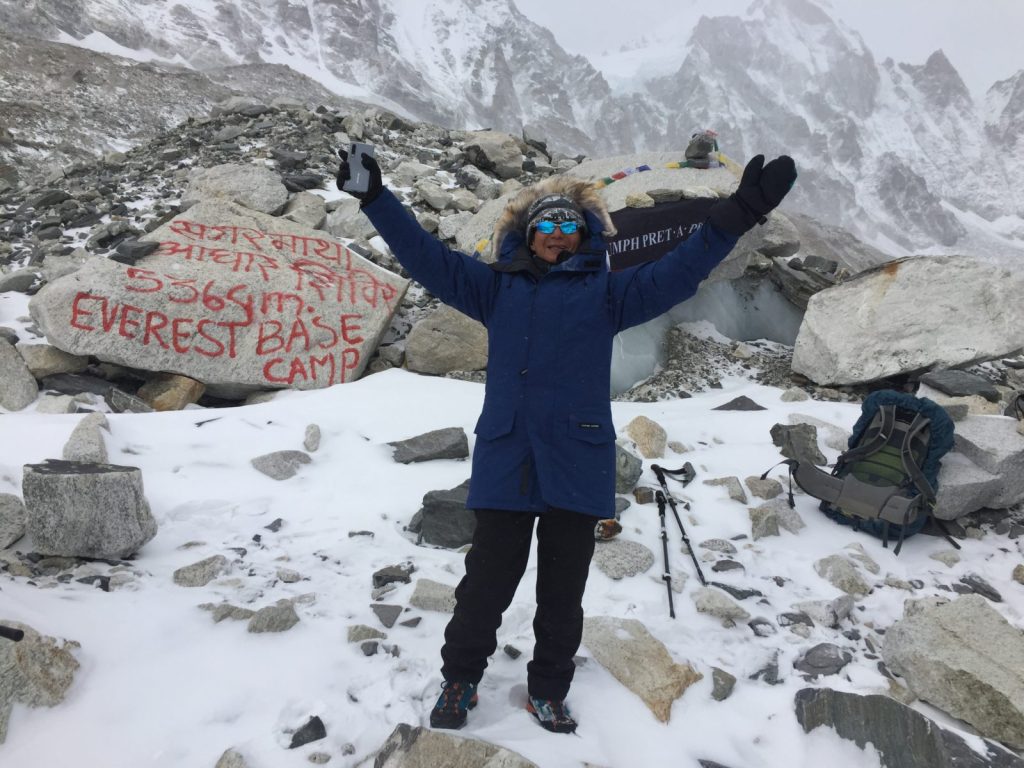
Everest base camp trek with the highest golf tee-offs by a foreigner. I took Harry Tan, a 71-year-old trekker from Singapore, to Everest base camp on a trek (not a climb to the top). I devised the idea to make this a trek to Everest base camp with a twist. This idea came to me on the morning of 7th December as he was flying here to make him tee off from 3 places above the altitude of 5000 meters. I had known him since 2015 when he came to golf with members of the Seletar golf club before the massive earthquake on 25th April 2015. He did a short trek in 2016 and was here in March this year with other club members. He is a keen golfer and part-time Physical Education teacher at Nanyang Technical University. 8th to 13th December 2019. We did this trek on our regular itinerary by flying to Lukla, trek to Namche, a side acclimatization trek to Amadablam base camp, etcetera. We hiked to Dingboche according to our plan. It started snowing lightly on the 6th morning from around 6.30 am. Upon reaching Dingboche, we stopped in a shop so Harry could buy warmer gloves, as the two pairs he brought from Singapore were not doing the ‘job.’ So instead, he ended up buying a pair of feather mittens. We just hung around the lodge, eating/drinking hot food and beverages. It continued to snow lightly for around 22 to 24 hours with occasional short breaks. 14th December 2019 We started our hike on a partially cloudy/foggy morning in the snow between 30 and 50 centimetres in depth. Despite December being the slow season, 70 to 100 other trekkers were on the trail. We reached our destination Lobuche 4940 meters, at 4 pm with the boots all damp. 15th December 2019 This was a massive day as Harry would be teeing off from 2 above 5000 meters. It began snowing lightly from 7 am, with the wind swirling up the valley behind us, blowing snow/sand. We hiked for about 90 to 100 minutes before reaching the flattish ground on Lobuche pass to Gorakshep 5180 meters. We stopped to bring out our 3 Wood driver, rubber tee, and an ecobioball manufactured by Albusgolf. These balls were imported from Europe 3 years ago for my project. It was a complete whiteout when Harry did the first-ever 5000-meter tee-off by a foreigner, a fellow Singaporean; Mark arrived just in time to witness this feat. We became friends six days ago in Namche Bazaar and crossed paths regularly on the trail. We continued on the lateral moraine towards Gorakshep. We had a quick lunch and left for the Everest base camp. We were the last to reach EBC and planned to avoid unnecessary attention from other trekkers. However, the other trekkers talked about a Singaporean with a golf club and wondered what he would do with it. We reached EBC trudging through snowy/icy conditions with strong wind gusts. Harry had to practice his swings with five layers of jackets in cold and windy conditions, not an easy feat for someone from sea level and a warm tropical country. Nevertheless, he managed to get an excellent swing. We headed back to Gorakshep for the night. Unfortunately, we learned that the overnight temperature was between -18 to -20 degrees Celcius. 16th December 2019 This was another significant day as Harry was going to tee off from Gorakshep at 5180 meters, and as it was a very clear day, once more from Lobuche pass. So Harry teed off from Gorakshep and Lobuche pass (a world difference between a foggy morning and a bright sunny day). We stopped at Pheriche and not Pangboche as planned due to the conditions of the trail. We had been walking on snowy/icy trails for the fourth day. 17th December 2019. We had planned to reach Namche Bazaar on this day. Instead, we had a gloriously bright morning with 360-degree views. Shomare the first settlement after leaving Pheriche, took us nearly two hours in snowy and icy conditions. On regular days it is only a 45-minute hike. There are patches of very icy trails where communal taps are left running to avoid pipes bursting below freezing temperatures. Before reaching Pangboche (standard time 90 minutes), which had taken us more than 3 hours, I gave Harry the option of flying down to Lukla by helicopter, bypassing these treacherous conditions and avoiding getting injured. Harry was happy to fly by chopper as it would also be his first experience. First, however, we had to wait a few minutes for the helicopter to bring cargo on a sling to arrive, leave the load, and get us to Lukla. We arrived in Lukla after a short 7 minutes but a thrilling flight by helicopter. We had a relaxing afternoon in Lukla, basking in the sun, having a warm shower, and the last night’s party with our talented staff Sundar Rai. 18th December 2019. We got to the airport terminal at 8 am and had a three-hour delay. We had to wait in the cold airport terminal. We were happy to leave Lukla when our aeroplane finally arrived. Harry was dropped off at his airline office to change his flights and was free to sort out his things for the afternoon. 19th December 2019 We dropped into the airline’s office to upgrade Harry’s flight before heading to the airport. Finally, we bid adieu at the airport; another innovative adventure ended. Conclusion. We are trying to get a few media companies to print this story. No matter what others may think or say, I think this achievement is no ordinary feat. It is unlikely to be matched or beaten for some time to come. The combination of a 71-year-old foreigner, trekking to EBC in the winter snow, and teeing off above 5000m is a difficult act to put together. This story of this incredible feat was published in a reputed National weekly
Vesak day
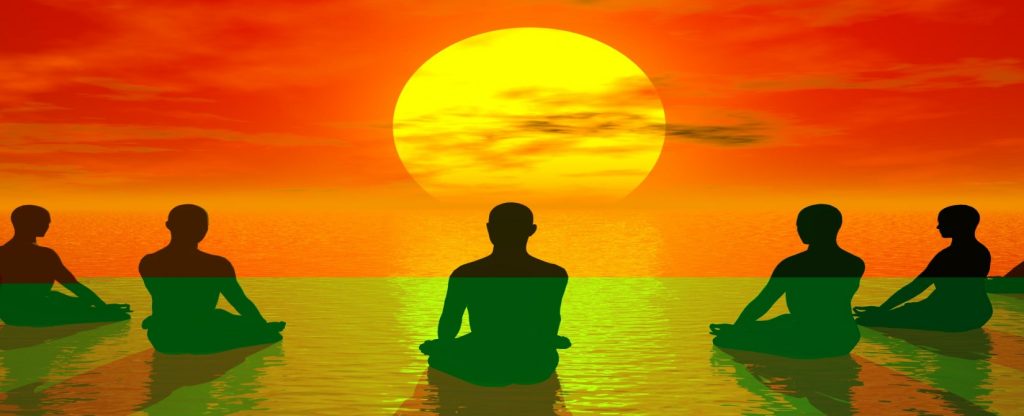
Vesak Day or Buddha Purnima 26th May 2021 15th May 2020 18th May 2019 Vesak day is also known as Buddha Jayanti (Buddha’s birthday) in Nepal. His first name was Siddhartha Gautama. Siddhartha Gautama was born in 563 BCE in Lumbini, which is now part of Modern Nepal. Birth and birthplace of Lord Buddha Siddhartha was the son of King Suddhodhan and Queen Maya Devi, the Ruler of Kapilavastu. Siddhartha was born in Lumbini, in a forest of Sal trees – Latin name, Shorea Robusta. Lumbini now lies in Rupendehi district, Province number 5 of modern Nepal. Lumbini was listed as a UNESCO World Heritage site in 1997. Buddha was born on a full moon day, achieved enlightenment on the same day of the same month 35 years later, and gained Nirvana on the same full moon day at the ripe old age of eighty. This day is also known as Buddha Purnima (full moon). Buddha means the enlightened one. Buddha was also known as Shakyamuni. Gautam Buddha Buddha left his physical body and attained Pari Nirvana at the age of eighty. Nirvana is a state where one gets out of the circle of life and death. The Life of Buddha It is said that soon after his birth, Siddhartha took seven steps, and before each foot touched the ground, a lotus flower bloomed for each of the seven steps. He took the seven steps towards the north immediately after birth and looked around for supreme beings in this universe. Then, he raised a finger to announce in the Pali language. * “Ako hamasmi natho” I am the senior-most. * ” Ako hamasmi loko” I am the first and foremost. * “Ako hamasmi shresth” I am the supreme one. * These words are phonetically spelt and roughly interpreted in layman’s terms, so most of us can understand them. Maya Devi gave birth to Buddha near Lumbini Garden’s pond while in her parental home. He was given a bath in the garden pond at Lumbini. That same pond is now known as Siddhartha Kunda. Kunda means either a pond or a lake in Sanskrit. Maya Devi’s idol was built at the very spot where Siddhartha was given birth. Maya Devi passed away a week after giving birth to Siddhartha. A holy man prophesized that Siddhartha would either be the greatest Ruler or the most exceptional spiritual leader. His father, the king, obviously desired his son to be the greatest emperor ever. So the king brought up young Siddhartha in opulence and sheltered him from the realities of life and hardships. Siddhartha lived his life as a perfect prince. He loved all the luxuries of life as a young man. He was married to Yasodhara at sixteen and had a son called Rahul. His princely lifestyle continued to the age of 29. Quest for the remedy of suffering. It was not too long before Siddharta’s life changed drastically. One day he and his good friend snuck out of the palatial quarters to wander around the city. Not long before, he started observing various types of sufferings humanity faced. The nightmares began to be felt within him. Siddhartha saw diseases, old age, and death. He also came across a monk who had donated all his belongings on his quest for humankind’s welfare. Siddhartha was deeply moved by this outing which made him restless with questions about finding the way out of this circle of life and death. He wanted to find a way to end all these sufferings. So one day, he quietly sneaked out of the palace to search for the answers/ways to alleviate the anguish. The Ascetic Life before Enlightenment Siddhartha lived as an ascetic for the next six years. He studied and meditated using verses from various religious teachers as his guide. He joined a group of five ascetics to practice his new way of life. His devotion to his quest was so dedicated that the five ascetics soon became Siddhartha’s followers. He redoubled his efforts when the answers he sought did not appear while enduring pain, refusing water and fasting to near starvation. However, hard Siddhartha tried, he could not reach the level of achievement he sought. Finally, he got up from his meditation and bathed in a nearby river. A young village girl saw the starving sage and offered him a bowl of rice pudding. He suddenly realized that physically punishing the body was not the way to achieve personal liberation. He found the answer to be the middle path. He ate the rice pudding and drank water after bathing in the river. The five ascetics were furious with Siddhartha for ‘giving up the ascetic life and what they considered ‘following the ways of the flesh, and they immediately left him. Siddhartha encouraged people to walk on the path of balance instead of symbolizing extremism, the well renowned – Middle way. The Buddha Surfaces One night, Siddhartha sat under a Bodhi tree, vowed not to get up until the truths he pursued were found, and he meditated until the sun rose the next morning. He remained in the same spot for several days, observing his whole life and previous lives while purifying his mind in meditation. During this period, he overcame Mara’s threats, an evil demon who had challenged his right to become a Buddha. Siddhartha touched the ground with his hand and asked the Earth to bear witness to his enlightenment when Mara tried to claim the enlightened state as his own, which Earth did and banished Mara. Furthermore, a vision formed in his mind of all that took place in the universe, and Siddhartha found the answers to the questions he had been searching for over so many years. Thus, Siddhartha Gautama became the Buddha in that moment of pure enlightenment – ‘he who is awake.’ Buddha’s Teachings. Equipped with his new wisdom, the Buddha was hesitant to teach initially because what he knew could not get through to the others in words. Legend
Upper Mustang trekking general information
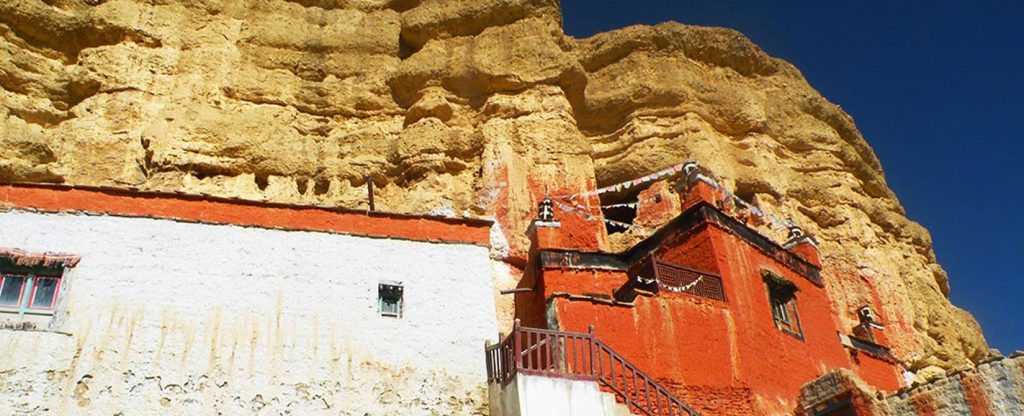
Upper Mustang trekking – General information The Upper Mustang region lies in the Northern part of the Mustang district in Nepal. It used to be one of the famous trading routes between Nepal and Tibet. The people of Mustang practice Tibetan Buddhism and speak a Tibetan dialect. It once was an independent Kingdom from 1380 until it was annexed into Nepal in the 18th century. The people of Upper Mustang practice animal husbandry, trading, and some limited seasonal farming. Farming was always limited due to its position in the Trans Himalayas with a semi-arid climate. However, the receding glaciers have made it even more difficult to cultivate in this high land in recent years. So much so that some villages have been abandoned, and the inhabitants have migrated elsewhere: ironic for the place called Smon-Thang in Tibetan, which means fertile plain. For more details about Upper Mustang To reach Upper Mustang, one must travel northwards of the Kali Gandaki Valley, the most in-depth ravine globally, with Mount Nilgiri 7055 meters – 7134 meters and Mount Dhaulagiri 8167 meters, the seventh highest peak in the world to its South. The average altitude of the Mustang is around 4000 meters. The capital, Lo Manthang, is a walled city. Trekkers were only allowed to visit the Upper Mustang in 1992. Nepal government charges a special area permit of US$500 for ten days and $50 for every additional day in this area. A liaison office must also accompany the visiting international groups to keep close supervision to protect centuries-old local traditions and cultures. Due to this high permit fee, less than 1000 trekkers visit this region every year. Only the Bonafide Trekking companies of Nepal can obtain this special area permit. For more on Lo Manthang Lo Manthang is known for its high whitewashed mud-brick walls, Gompas, and the King’s five-storey palace. It is believed to have been constructed in the 15th century. There are four significant Gompas within the walled city. An average trekking duration depends on the number of stops made in various villages. However, you can do a comfortable 10-15 days round trip journey to Upper Mustang. It involves trekking on dry, dusty trails with several passes to go over to reach Lo Manthang. The road from Tibet already got Lo Manthang in 2001, and a fair-weather highway is under construction from Jomsom, the administrative headquarter of Mustang District. Due to road construction, locals have turned to ride motorcycles or horse riding. Upper Mustang is still mysterious and surreal. Please visit Upper Mustang while you still have a chance to discover its unspoiled beauty. We do organize a hassle-free trekking holiday to Upper Mustang. The King of Mustang, Jigme Paljor Bista, passed away on 16th December 2016, aged 86. This article is by Raj Tamang, Chief Experience Officer of Responsible Adventures. Check out our Trekking packages for Nepal, Bhutan, India, and Tibet.










